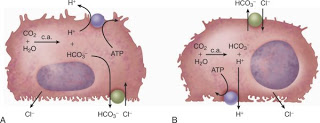Heard a great talk today from the 2007 recipient of the Homer Smith Award & editor of Kidney International: Qais Al-Awqati of Columbia. The full details of much of the talk can be found in this JASN article describing his acceptance talk at the ASN, but I will attempt to paraphrase.
The collecting duct has two types of cells: principal cells (the aldosterone-responsive, ENac-expressing cells which also mediate water reabsorption via ADH) and the intercalated cells. The intercalated cells come in two different varieties: alpha-intercalated cells (which secrete acid) and beta-intercalated cells (which secrete base). The alpha-intercalated cells (on the left in the figure) are tall, columnar epithelial cells which contain apical H+ ATPase, explaining its ability to secrete protons. The beta-intercalated cells (on the right) in contrast are shorter, flatter cells which contain an apical chloride-bicarbonate exchanger (called pendrin) which enables it to secrete base.


The interesting thing is that inducing metabolic acidosis results in the conversion of beta-intercalated cells to alpha-intercalated cells–giving the kidney a greater ability to secrete protons and return pH to the normal range. This conversion event is regulated by a secreted extracellular matrix molecule called hensin. Since these cells evidently retain the ability to switch between markedly different cellular phenotypes, it has become of interest to the ever-evolving field of stem cell biology.



Thanks for pointing out my typo! I’ve made the change. Cheers.
Correction: metabolic acidosis causes conversion of beta cells into alfa intercalated cells (vice-versa is stated in your note) so more protons are excreted. In steady state, beta cells are minimally active since there is no need to excrete base.